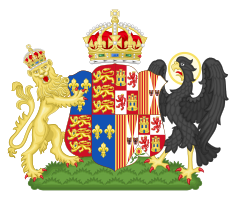Catherine of Aragon facts for kids
Quick facts for kids Catherine of Aragon |
|
|---|---|
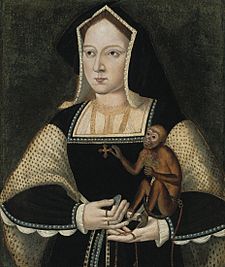
Portrait by Lucas Horenbout, c. 1525
|
|
| Queen consort of England | |
| Tenure | 11 June 1509 – 23 May 1533 |
| Coronation | 24 June 1509 |
| Born | 16 December 1485 Archiepiscopal Palace, Alcalá de Henares, Castile, Spain |
| Died | 7 January 1536 (aged 50) Kimbolton Castle, Cambridgeshire, England |
| Burial | 29 January 1536 Peterborough Cathedral, Peterborough, England |
| Spouse | |
| Issue among others... |
|
| House | Trastámara |
| Father | Ferdinand II of Aragon |
| Mother | Isabella I of Castile |
| Religion | Roman Catholicism |
| Signature | |
Catherine of Aragon (born 16 December 1485 – died 7 January 1536) was the Queen of England. She was the first wife of King Henry VIII. Their marriage lasted from 11 June 1509 until it was ended on 23 May 1533.
Catherine was born in Spain. Before marrying Henry, she was the Princess of Wales. This was because she was married to Henry's older brother, Arthur, Prince of Wales, for a short time before he died.
Catherine was the daughter of Isabella I of Castile and Ferdinand II of Aragon, who were powerful rulers in Spain. She was promised to Prince Arthur, the future king of England, when she was only three years old. They married in 1501, but Arthur died just five months later.
Catherine then spent several years in a difficult situation. In 1507, she became the first known female ambassador in European history, representing Spain in England. She married Arthur's younger brother, Henry VIII, in 1509, shortly after he became king. In 1513, she even served as the regent of England for six months while Henry was fighting in France. During this time, the English army defeated a Scottish invasion at the Battle of Flodden. Catherine played an important part by giving a brave speech to inspire the English troops.
By 1525, King Henry VIII wanted a son to be his heir. Since Catherine had not given him a surviving son, he became unhappy with their marriage. Their only surviving child was a daughter, Mary. At that time, it was not common for a woman to rule England. Henry wanted to end his marriage to Catherine. This decision led to big changes, including England separating from the Catholic Church.
When the Pope refused to end the marriage, Henry decided to take control of religious matters in England himself. In 1533, his marriage to Catherine was declared invalid. Henry then married Anne Boleyn. Catherine refused to accept this and still believed she was the rightful Queen. Many people in England supported her. Henry, however, only called her the "Dowager Princess of Wales." Catherine was sent away from court and lived the rest of her life at Kimbolton Castle. She died there in January 1536 from cancer. The English people greatly respected Catherine, and her death caused much sadness. Her daughter Mary later became the first undisputed Queen of England in 1553.
Catherine was a very intelligent and respected woman. She supported education and helped the poor. She was friends with famous scholars like Erasmus and Thomas More. Even her opponent, Thomas Cromwell, said she was incredibly strong.
Contents
Early life and education

Catherine was born on 16 December 1485, in Spain. She was the youngest surviving child of King Ferdinand II of Aragon and Queen Isabella I of Castile. Catherine was quite short with long red hair, blue eyes, and a fair complexion.
Her family had connections to the English royal family. Her great-grandmother, Catherine of Lancaster, was an English princess. This connection made Catherine a good choice for a future English queen.
Catherine received an excellent education from her tutor, Alessandro Geraldini. She studied many subjects, including history, philosophy, and religion. She was very religious and her strong Roman Catholicism played a big part in her life. She learned to speak, read, and write in Spanish and Latin, and also spoke French and Greek. The famous scholar Erasmus said that Catherine "loved good literature." She also learned important skills like cooking, sewing, and dancing.
Because of her royal background and English family ties, Catherine was seen as a perfect wife for Arthur, Prince of Wales. Marrying her would strengthen the House of Tudor's claim to the English throne. Catherine and Arthur were married by proxy (meaning someone stood in for them) in 1499. They wrote letters to each other in Latin until they were old enough to live together.
Catherine arrived in England in 1501 with a large group of attendants. This included some African servants, like the trumpeter John Blanke. These servants were seen as a sign of her family's wealth and power.
Wife and widow of Arthur
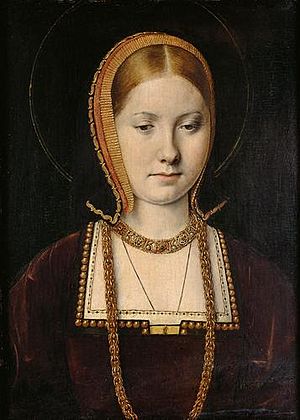
Catherine, who was 15 years old, met Arthur on 4 November 1501. Arthur wrote to her parents that he would be "a true and loving husband." He also told his own parents he was very happy to see his "lovely bride." They had written letters in Latin, but found they spoke Latin differently and couldn't understand each other at first.
Ten days later, on 14 November 1501, they were married at Old St Paul's Cathedral. Catherine's family had promised a large sum of money, called a dowry, as part of the marriage agreement.
After their wedding, Arthur and Catherine moved to Ludlow Castle in Wales. Arthur was there to govern the region, as was his duty as Prince of Wales. A few months later, both became very ill, possibly with a disease called the "sweating sickness." Arthur died on 2 April 1502. Catherine, at 16 years old, recovered but was now a widow.
King Henry VII, Arthur's father, faced a problem. He had to return Catherine's dowry to her father if she went back to Spain. To avoid this, it was suggested that Catherine marry Henry VII's second son, Henry, who was five years younger than her. However, Catherine's mother died, which made her less valuable in the marriage market. Her father, Ferdinand II, also delayed paying the rest of her dowry. This made it uncertain if the marriage to Prince Henry would ever happen.
Catherine lived almost like a prisoner in London. She wrote letters to her father complaining about her situation. In one letter, she said, "I choose what I believe, and say nothing. For I am not as simple as I may seem." She had little money and struggled to support herself and her ladies-in-waiting. In 1507, she became the Spanish ambassador to England. This made her the first female ambassador in European history.
Marrying Arthur's brother required special permission from the Pope. This was because canon law (church law) usually did not allow a man to marry his brother's widow. Catherine stated that her marriage to Arthur was never fully completed.
Queen of England
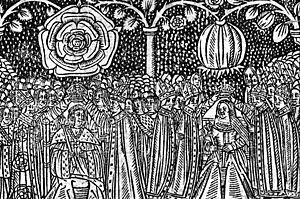
Wedding and coronation
Catherine's second wedding took place on 11 June 1509. This was seven years after Prince Arthur's death. She married Henry VIII, who had just become king. The private ceremony was held at Greenwich Palace. Catherine was 23 years old.
On 23 June 1509, the day before their coronation, a large and excited crowd greeted the couple. They spent the night at the Tower of London. On 24 June 1509, Henry VIII and Catherine were crowned together at Westminster Abbey. A grand banquet followed at Westminster Hall. Many new knights were created to celebrate the coronation.
In the months that followed, Catherine made a great impression on the English public. She was well-liked and respected by the people.
Influence as Queen
On 11 June 1513, Henry made Catherine the Regent of England. This meant she was in charge of the country while he was fighting in France.
Catherine was very involved in defending England. When the Scots invaded, she ordered an army to be raised. She even rode north in full armor to speak to the troops, even though she was pregnant. Her inspiring speech was widely praised. After the English won the Battle of Flodden, Catherine sent a piece of the Scottish King's bloody coat to Henry as a trophy.
As she got older, Catherine became even more religious. She also continued to support learning and education. She made sure her daughter, Mary, received a good education. Because of Catherine's influence, education for women became more popular. She also gave a lot of money to colleges.
However, King Henry still desperately wanted a male heir. The Tudor dynasty was new, and a son would make its claim to the throne stronger. People remembered past civil wars when a woman had tried to inherit the throne.
In 1520, Catherine's nephew, Emperor Charles V, visited England. Catherine encouraged Henry to form an alliance with Charles instead of France. Two years later, England went to war with France.
Pregnancies and children

Catherine had several pregnancies during her marriage to Henry VIII. It was very important for kings to have sons to continue their family line.
| Name | Birth | Death | Details |
|---|---|---|---|
| Daughter | 31 January 1510 | Born stillborn (did not survive). | |
| Henry | 1 January 1511 | 22 February 1511 | Died suddenly as a baby. |
| Son | c.17 September 1513 | Either stillborn or lived for only a few hours. | |
| Son | November/December 1514 | Born stillborn. | |
| Mary | 18 February 1516 | 17 November 1558 | Became Queen Mary I of England. |
| Daughter | 10 November 1518 | Born stillborn. | |
The King's great matter
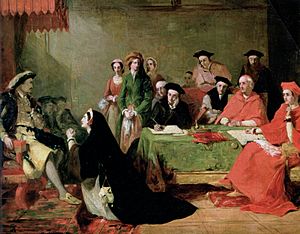
By 1525, King Henry VIII was very interested in Anne Boleyn, one of Queen Catherine's ladies-in-waiting. Henry wanted to end his marriage to Catherine because she had not given him a surviving son. He started to believe that his marriage was wrong in God's eyes. He thought the Bible said that marrying your brother's wife would lead to having no children.
Henry desperately wanted to end his marriage. Catherine strongly disagreed. She said, "God never called me to a nunnery. I am the King's true and legitimate wife." Henry tried to get the Pope to agree to end his marriage. He argued that the special permission given for him to marry Catherine was based on false information.
At this time, the Pope was a prisoner of Catherine's nephew, Emperor Charles V. This made it very hard for Henry to get what he wanted. Henry's chief advisor, Cardinal Thomas Wolsey, tried his best to help the King.
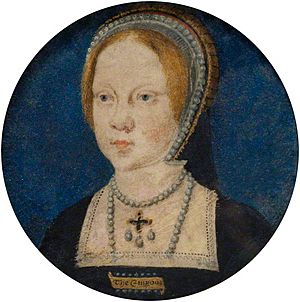
Wolsey even held a special church court in England. Both Henry and Catherine attended. But the Pope did not want a decision made in England. He ordered that the case be decided in Rome. The Pope also told Henry not to marry again until Rome had made a decision. Wolsey failed to get the annulment, and Henry removed him from his position in 1529.
A year later, Catherine was sent away from court. Her rooms were given to Anne Boleyn. When the Archbishop of Canterbury died, Thomas Cranmer, who supported Anne Boleyn's family, was chosen for the job.
Many people supported Catherine. These included John Fisher, Thomas More, Henry's sister Mary Tudor, Queen of France, and Catherine's nephew Emperor Charles V. Even Protestant leaders like Martin Luther and William Tyndale supported her.
Banishment and death
After meeting with the King of France, Henry secretly married Anne Boleyn. On 23 May 1533, Archbishop Cranmer declared Henry's marriage to Catherine invalid. Five days later, he ruled that Henry and Anne's marriage was valid.
Catherine continued to call herself Henry's rightful wife and England's only true queen until her death. Her servants also continued to address her as Queen. Henry, however, only allowed her to be called "Dowager Princess of Wales."
Catherine was moved to several different castles. She was finally sent to Kimbolton Castle in Cambridgeshire. There, she stayed mostly in one room, leaving only for church. She was not allowed to see her daughter Mary. They were also forbidden from writing to each other, but some kind people helped them secretly exchange letters. Henry offered them better living conditions if they would accept Anne Boleyn as the new queen, but both Catherine and Mary refused.
In late December 1535, Catherine felt she was dying. She wrote her will and asked her nephew, Emperor Charles V, to protect her daughter.
Catherine died at Kimbolton Castle on 7 January 1536. The next day, the King heard the news. At the time, some people rumored that she had been poisoned. However, modern doctors believe her death was caused by heart cancer, which people didn't understand back then.
Catherine was buried in Peterborough Cathedral. Her funeral was held with the honors due to a Dowager Princess of Wales, not a queen. Henry did not attend, and he forbade Mary from going.
Faith and appearance
Catherine was a very religious person. She was a member of a special religious group called the Third Order of Saint Francis. She always made sure to follow her religious duties, even while being Queen. After her marriage was ended, she said, "I would rather be a poor beggar's wife and be sure of heaven, than queen of all the world and stand in doubt thereof."
She focused on prayer, church services, and confession. She was aware of some problems within the church, but she did not support the ideas of Martin Luther that led to the Protestant Reformation.
In her youth, Catherine was described as "the most beautiful creature in the world." Later in her life, people like Thomas More said that "few women could compete with the Queen in her prime."
Legacy and memory

Catherine supported the idea that women should be educated. She even asked Juan Luis Vives to write a book called The Education of a Christian Woman, which was dedicated to her. She was also admired for starting a large program to help the poor. She supported Renaissance humanism and was friends with scholars like Erasmus and Thomas More. Some people saw her as a martyr (someone who suffers for their beliefs).
When her daughter Mary I of England became Queen, Mary declared that her parents' marriage had been "good and valid." Many portraits of Catherine were painted after her death. Her speech at the trial where her marriage was discussed is famously shown in Shakespeare's play about Henry VIII.
Her tomb in Peterborough Cathedral is still there today. It is often decorated with flowers or pomegranates, which were her special symbols. The tomb is marked "Katharine Queen of England."
In the 20th century, Queen Mary of Teck (wife of King George V) had Catherine's grave improved. Now, banners there show Catherine as a Queen of England. Every year, a service is held at Peterborough Cathedral to remember her. People place candles, pomegranates, and flowers on her grave. The Spanish Ambassador to the United Kingdom has even attended these services. There is also a statue of Catherine in her birthplace, Alcalá de Henares, Spain.
Many books have been written about Catherine of Aragon. Historians like Garrett Mattingly, Alison Weir, and Antonia Fraser have explored her life. Giles Tremlett and Julia Fox have also written popular biographies about her.
Places and statues
- In Alcalá de Henares, Spain, where Catherine was born, there is a statue of her as a young woman holding a book and a rose.
- Peterborough, England, is a twin city with Alcalá de Henares. Children from both cities learn about each other.
- Many places in Ampthill are named after Catherine. There is also a cross called "Queen Catherine's Cross" in Ampthill Great Park, where she lived during her divorce.
- Kimbolton School has a science and math building named the "Queen Katherine Building" (QKB).
Spelling of her name
Her Spanish birth name was "Catalina." However, "Katherine" quickly became the common spelling in England after she married Arthur. Catherine herself signed her name in different ways, such as "Katherine," "Katherina," "Katharine," and sometimes "Katharina." Her first husband, Arthur, called her "Princess Katerine." Her daughter, Queen Mary I, referred to her as "Quene Kateryn" in her will. In the 16th century, people often spelled names in different ways.
King Henry VIII had special symbols, called "loveknots," built into his palaces. These showed the initials "H & K" for Henry and Katherine. Other items belonging to them, like gold cups, also had these initials. Her tomb in Peterborough Cathedral is marked "Katharine Queen of England."
See also
 In Spanish: Catalina de Aragón para niños
In Spanish: Catalina de Aragón para niños



